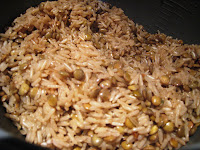Unfortunately, it seems like a lot of people are taking in the arguments in Eating Animals and concluding that the solution lies in abolishing factory farming, not embracing veganism (and I think that's probably by design). That's what happens when you focus on the animal welfare story instead of the animal rights story. Even if "happy meat" is a total myth, people really really want to believe that it's possible.
Here are some quotes from the book that I thought were particularly interesting.
From p. 109:
In the past fifty years, as factory farming spread from poultry to beef, dairy, and pork producers, the average cost of a new house increased nearly 1,500 percent; new cars climbed more than 1,400 percent; but the price of milk is up only 350 percent, and eggs and chicken meat haven't even doubled. Taking inflation into account, animal protein costs less today than at any time in history. (That is, unless one also takes into account the externalized costs -- farm subsidies, environmental impact, human disease, and so on -- which makes the price historically high.
By the way, according to the "Broilers: production and income" worksheet found on this page, there were 34 million broiler chickens produced in 1934 and 8.7 billion produced in 2oo4 -that's 256 times more in 70 years.
Here's another interesting passage (p. 220-221):
The idea of robustly humane animal agriculture isn't so much seen as objectionable to most people who work in the name of animal rights as it is hopelessly romantic. From the vantage of animal rights, the animal welfare position is like proposing we take away basic legal rights for children, offer huge financial incentives for working children to death, place no social taboo on using goods made from child labor, and somehow expect that toothless laws advocating "child welfare" will ensure that they are treated well.
In a section discussing Michael Pollan's work, Foer writes (p. 229):
...virtually all of the time, one's choice is between cruelty and ecological destruction, and ceasing to eat animals... A meat industry that follows the ethics most of us hold (providing a good life and an easy death for animals, little waste) is not a fantasy, but it cannot deliver the immense amount of cheap meat per capita we currently enjoy.
And here's a great, persuasive section from p. 257-258:
A good number of people seem to be tempted to continue supporting factory farms while also buying meat outside that system when it is available. That's nice. But if it as far as our moral imaginations can stretch, then it's hard to be optimistic about the future. Any plan that involves funneling money to the factory farm won't end factory farming... If anyone finds in this book encouragement to buy some meat from alternative sources while buying factory farm meat as well, they have found something that isn't here.If we are at all serious about ending factory farming, then the absolute least we can do is stop sending checks to the absolute worst abusers. For some, the decision to eschew factory-farmed products will be easy. For others, the decision will be a hard one... the ultimate question is whether it is worth the inconvenience. We know, at least, that this decision will help prevent deforestation, curb global warming, reduce pollution, save oil reserves, lessen the burden on rural America, decrease human rights abuses, improve public health, and help eliminate the most systematic animal abuse in world history... How would making such a decision change us? ... One of the greatest opportunities to live our values -- or betray them -- lies in the food we put on our plates.
Finally, in the closing passages, he writes this (p. 266-267):
It shouldn't be the consumer's responsibility to figure out what's cruel and what's kind, what's environmentally destructive and what's sustinable. Cruel and destructive food products should be illegal. We don't need the option of buying children's toys made with lead paint, or aerosols with chlorofluorocarbons, or medicines with unlabeled side effects. And we don't need the option of buying factory-farmed animals.However much we obfuscate or ignore it, we know that the factory farm is inhumane in the deepest sense of the word. And we know that there is something that matters in a deep way about the lives we create for the living beings most within our power. Our response to the factory farm is ultimately a test of how we respond to the powerless, to the most distant, to the voiceless -- it is a test of how we act when no one is forcing us to act one way or another. Consistency is not required, but engagement with the problem is.



